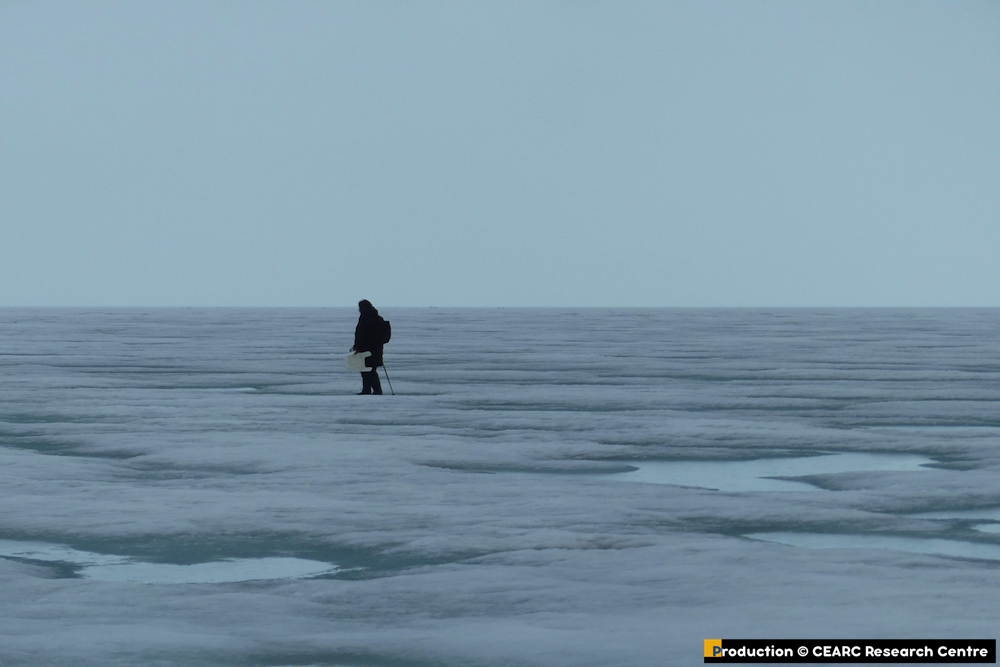Woman on this ice / Seule sur la glace
Together with the community, we have been asking people to tell us stories, stories that matters to them. Sea ice was a ‘character’ that featured in many of these stories. ‘Naluarnga! I don’t know in Tunumiisut (East Greenlandic). This is an uncommonly short word, performed as a refrain escaping from the mouth of the Ittoqqortoormeermii, the inhabitants of Ittoqqortoormiit during the autumn 2021. The days were getting shorter at the mouth of Ugeer (‘Winter’ in Tunumiisut), and I was randomly asking to locals this question: “When will the ice wrap itself again around the 350-inhabitant town?” I rapidly understood it was a humility-deprived, a question from a world we aim at foresee, at control’ (Tanguy Sandré, rewrite from fieldnotes, October 2021). In the meanwhile, convergent stories were told: it was earlier before, we are now waiting a long while for the ice to be stable and thick enough to be anew covered by the tracks of sled dogs and snowmobiles. In June 2022, the question could have been reverted: “When will the ice melt again around the town?” But we, researchers, we have learnt, we already know the answer. We therefore pay attention to new convergent stories: this is very unusual that there is still ice now, we haven’t seen that for 20 years. Change in sea ice are ubiquitous and non-linear, hence impossible to foresee or to imagine. Hence, people rely on their ability to live with high uncertainties, which is culturally rooted in the attitude of not making plan.

by / par Tanguy Sandré
Quand nous sommes sur place, nous demandons souvent aux gens de nous raconter des histoires, des histoires qui comptent pour elles et eux. La glace de mer est un "personnage" qui figure dans nombreuses de ces histoires. « Naluarnga ! Je ne sais pas en Tunumiisut. Il s'agit d'un mot inhabituellement court, exécuté comme un refrain s'échappant de la bouche des Ittoqqortoormeermii, les habitants et les habitantes d'Ittoqqortoormiit durant l'automne 2021. Les jours raccourcissaient à l'embouchure d'Ugeer (hiver), et je posais au hasard cette question aux habitant·es : ‘Quand la glace s'enroulera-t-elle à nouveau autour de la ville ?’ J'ai rapidement compris qu'il s'agissait d’une question qui présentait un certain manque d'humilité, d'une question provenant d'un monde où l’on cherche à prévoir, à contrôler » (Tanguy Sandré, réécriture à partir de notes de terrain, octobre 2021). Entre-temps, des histoires convergentes ont été racontées : « c'était bien plus tôt avant », « on attend maintenant bien longtemps que la glace soit suffisamment stable et épaisse pour être à nouveau recouverte par les traces des chiens de traîneau et des motoneiges ». En juin 2022, la question aurait pu être inversée : « Quand la glace fondra-t-elle à nouveau ? ». Mais nous, chercheur·es, nous avons appris, nous connaissons déjà la réponse. Nous sommes donc attentif·ves aux nouvelles histoires convergentes : « c'est très inhabituel qu'il y ait encore de la glace maintenant », « on n'a pas vu ça depuis 20 ans ». Les changements dans la glace de mer sont omniprésents, mais aussi non linéaires, donc impossibles à prévoir ou à imaginer. D’une certaine manière, les gens s’appuie sur leur capacité à vivre avec de grandes incertitudes, ce qui est culturellement ancré dans l'attitude de ne pas faire de plan, de « naviguer à vue ».



